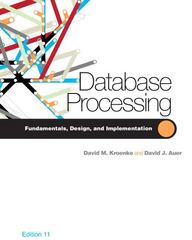Answered step by step
Verified Expert Solution
Question
1 Approved Answer
ELECTRICAL AND ELECTRONICS ENGINEERING & COMPUTER ENGINEERING E E E 2 4 8 | C N G 2 3 2 Logic Design S P R
ELECTRICAL AND ELECTRONICS ENGINEERING
&
COMPUTER ENGINEERING
E E E C N G
Logic Design
S P R I N G
PROJECT
Good Luck
EEE C N G
L o g i c D e s i g n
P R O J E C T
Page
TABLE OF CONTENTS
REGULATIONS
EXPERIMENT #
OBJECTIVE
PRELIMINARY WORK
Objectives
Creating the Functional Unit
Shift Resisters
Parallel in Parallel out shift register
CCU
DATAPATH DESIGN
DATAPATH TESTBENCH DESCRIPTION
For the Temperature Setting:
For the Humidity Setting:
TOPLEVEL DESIGN
PROJECT REPORT
TESTBENCH
EXPERIMENTAL WORK
Experimental Setup
EVALUATION
REFERENCES
EEE C N G
L o g i c D e s i g n
P R O J E C T
Page
REGULATIONS
Students are not permitted to perform an experiment without doing the preliminary work before coming to
the laboratory.
It is not allowed to do the preliminary work at the laboratory during the experiment.
Students, who do not turn in the complete preliminary work printout at the beginning of the laboratory session,
cannot attend the lab. No makeup is given in that case.
No food or drink in the lab.
Only the following excuses are valid for taking lab makeup:
Health Makeup: Having a health report from METU Medical Center.
Exam Makeup: Having an exam coinciding with the time of the laboratory session. The student needs
to notify the instructor in advance if this is the case.
Experiments will be done in teams of two.
Cheating or plagiarism is not tolerated. Plagiarism is a form of cheating as is using someone elses written
word with minor changes and no acknowledgement. If you are caught cheating or plagiarising, you will at the
very least receive a zero for the whole experiment. Disciplinary action may be taken.
Students who miss the lab two times without a valid excuse get zero as the laboratory portion of the course
grade.
Those who fail to get a satisfactory score from the laboratory portion may fail the class. This score is
expected to be but may be adjusted up or down with the initiative of the course instructor.
EEE C N G
L o g i c D e s i g n
P R O J E C T
Page
EXPERIMENT #
OBJECTIVE
In this project, you are required to design and implement a Datapath for a bit Smart Climate Control
System. Altera toolset and Modelsim will be used to code, simulate, and implement the design.
Students should prepare and submit a report before the LAB demo including all the codes, diagrams, and
simulation waveforms that they will demonstrate for experiment mentioned below.
In this Experiment the Datapath design will be demonstrated with your partner to the LAB instructor as
usual. The report must include all the module designs and simulations. Also, you'll need to test the overall
Datapath design the complete setup in Modelsim using inputs similar to what the Finite State Machine
FSM will provide in the upcoming project. However, for this particular project, follow the instructions
provided in the manual for feeding inputs.
EEE C N G
L o g i c D e s i g n
P R O J E C T
Page
PRELIMINARY WORK
A data path is a collection of functional units such as arithmetic logic units ALUs or multipliers that perform
data processing operations, registers, and buses. Along with the control unit it composes the central processing
unit CPU This lab introduces the concept of data path.
Objectives
After completing this lab, you will be able to:
Create the Functional units through hierarchical design
Understand the working of the CCU
Creating the Functional Unit
A data path comprises various elements, such as decoders linked to logical gates, facilitating the storage of
values in registers. Subsequently, these registers transmit data to the Central Control Unit CCU where
operations are executed based on specified opcodes. The resultant data is then stored in registers. This process
entails the design of data paths using modular units, which are combined to form a complete data path, termed
as hierarchical design. Establishing a simple hierarchical design aids in project development, as exemplified by
the construction of a bit shift register below.
SHIFT RESISTERS
Flip flops have the capability to retain a solitary binary digit, either a or a However, for the storage of
numerous binary digits, multiple flip flops are required. Since each flip flop is designed for the storage of one
binary digit, a series of n flip flops are interconnected to accommodate n bits of data. In digital electronics, a
Register serves as a mechanism employed for data storage purposes.
Below is an illustration of a Dflip flop alongside a sample module:
Figure : DFlip Flop
module dff DataclkQ;
input Dclk;
output reg
Step by Step Solution
There are 3 Steps involved in it
Step: 1

Get Instant Access to Expert-Tailored Solutions
See step-by-step solutions with expert insights and AI powered tools for academic success
Step: 2

Step: 3

Ace Your Homework with AI
Get the answers you need in no time with our AI-driven, step-by-step assistance
Get Started


